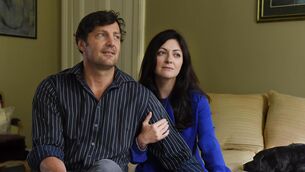Fathers who take children’s lives often motivated by love
Though it may be hard to credit, many fathers who take their children’s lives do it for love, rather than evil, according to an expert in the field.
Dr Kevin Browne believes there are two types of men who kill their children. The first is motivated by love and is wholly driven by suicidal tendencies, while the second is often motivated by revenge or jealousy.
Prof Browne, formerly professor of forensic and family psychology at the University of Birmingham and now with the University of Nottingham in England, said: “In the first type there may be many complex reasons, but in the end it always relates to depression or low self-esteem either towards the family situation or towards the work situation.
“These people, who we call family annihilators, always have a fear of losing their wives and children. They feel there is no future and they have all sorts of cognitive distortions.”
Prof Browne said fathers who kill their children and then take their own lives experience an overwhelming feeling of utter hopelessness and the inability to see any future.
He said suicidal feelings of hopelessness were uppermost in the minds of these people and once the decision had been taken to end his own life, the father would meticulously plan the demise of the rest of his family.
He said: “These people believe, if they commit suicide, they will lose their families and not be able to care for them, so they illogically convince themselves that the best way forward is to kill them all and meet them on the other side.
“It is an interesting twist on murder, because these types of killings have nothing whatsoever to do with evil, they are all to do with love,” he said.
According to research in the United States, roughly half of filicidal acts are committed by fathers. Fathers who killed their children were, on average, in their mid-30s and the mean age of their victims was five. They may have multiple victims. Sons and daughters were killed in equal numbers. Reasons included death related to abuse, mental illness (including psychosis and depression), and revenge against a spouse or partner. The method often involved wounding violence. Canadian research shows that, at the time of the offence, most of the perpetrators were suffering from a psychiatric illness, usually depressive disorder. Nearly a third were in a psychotic state.
Terri Morrissey, chairman of Aoibhneas, the women and children’s refuge, is accustomed to dealing with victims of domestic violence. Nonetheless, she was horrified by Tuesday’s murders and it reminded her of the Dunne case in Wexford in 2007 when sisters Leanne, five, and Shania, three, were smothered by their father, Adrian Dunne. The premeditated murder-suicide by him and his wife, Ciara, shocked the nation. Adrian strangled Ciara before hanging himself.
“It was like deja vu,” said Ms Morrissey. “When I saw on the news yesterday, it brought back memories of the Wexford case. In fact, it was that case that prompted me to commission research into the area in order to evaluate the level of danger women and children may face in their homes.”
Her current campaign to found a specifically designed children’s centre at the Aoibhneas women’s and children’s refuge was prompted by such tragedies. She is convinced, and research has supported her view, that there are signs that society could and should be picking up that these tragedies are looming.
The study, conducted by Candy Murphy, shows there are 20 identifiable triggers that can alert the Garda, social services and the medical profession to the factors that might result in tragedies like these.
“Anyone in contact with families, including doctors, the HSE, social services, priests, etc, should be aware of these triggers. There are well researched indicators that people should be aware of.”
Among them are depression, drug or alcohol abuse, past violence or erratic behaviour and financial pressures. “If you can tick a certain number of these, it is a sign of real danger,” said Morrissey, a psychologist. “I cannot say whether they apply in the cases in Ballycotton and Newcastle West but, where they do apply, they give a good indication of possible violence.
“You also have to realise different people have different ways of coping with difficulties in their lives. Some display amazing resilience, even in the face of terrible trauma, for example that couple held captive in Somalia.
“Children are particularly susceptible to ongoing stress within a family. We provide good support for children who come to us. Most of them are traumatised and the sad thing is that they are the lucky ones.”













